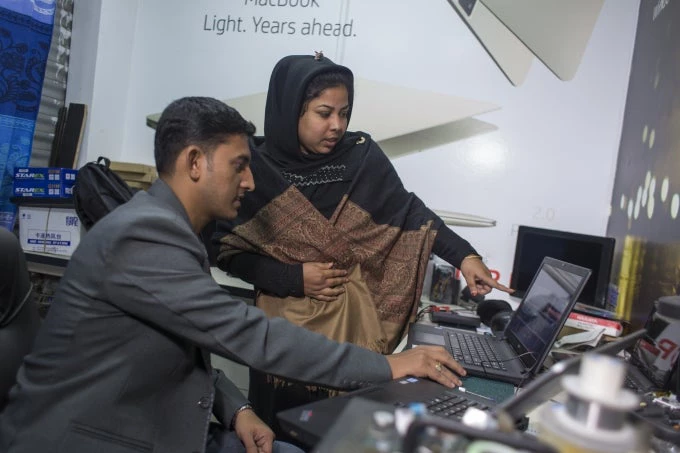
We are now experiencing the Fourth Industrial Revolution.
Our days are characterized by an explosion of innovative technologies blurring the lines between the physical, digital and cyber realities of our lives. This space is marked by technology breakthroughs in a number of fields, including robotics, nanotechnology, artificial intelligence (AI), biotechnology, quantum computing, the Internet of Things, fifth-generation wireless technologies (5G), 3D printing and fully autonomous vehicles.
To adapt to this new environment and ‘future-proof’ the nation, the youth need to learn how to engage with technology. The Bangladesh government is committed to embracing this new direction and has made digitization a national priority. The government has also called for greater skills development of the youth, especially in Information Communication Technologies (ICT), to ensure their employability in any industry. The National ICT Policy 2009 promotes the use of ICT tools in all levels of education and ensures access to education and research for people with special needs, among other measures. It aims to finally to create a sizeable cohort of ICT professionals who can meet competitive global requirements.
Take Mahmuda Siddika, 27, who owns a technology firm in Rajshahi district. She employs eight people, and supports her parents and children with her income. Mahmuda received training from the Rajshahi Mohila Technical Training Center, one of the polytechnics supported by the Skills and Training Enhancement Project (STEP).
“My business offers repairing services for electronic products and computer equipment. Recently, I won a contract to provide the Government of Bangladesh with uninterruptible power supply machines in over 60 sub-districts. I believe my success is entirely due to my training… the program offered me hands-on practical training, industry tours, internships, access to modern training equipment and well-trained teachers, ” she said.
Training institutes like the Rajshahi Mohila Technical Training Center need to build their capacity and infrastructure in order to be to develop strong ICT skills in students. Investment in computer labs, teacher training and electricity is needed, as well as curriculum development, to ensure relevance to industry. Whole professions are now being automated. Activities within occupations are being automated. This means, a car mechanic need not be a technology expert, but he or she needs to be familiar with those aspects of automobile repair that are being automated. Thus the competencies within occupations need to be systematically revised and updated to meet industry needs.
Given today’s pace of technology change and integration in a globalized business environment, high-level cognitive skills are in demand. Employers want workers who can operate necessary technologies and also think critically and communicate clearly. Polytechnics are gearing up to strengthen training on problem-solving and communication skills. The recent World Development Report: Learning to Realize Education's Promise showed that the learning outcomes of students at schools in Bangladesh are still very low. Vocational training institutes must compensate and often help students overcome weaknesses in basic literacy and numeracy skills.
Countries such as Switzerland, Austria and Germany, which rank highest in the Global Innovation Index, achieved very low youth unemployment because their training system is based on the shared responsibility of the training sector and employers and trade unions, as well as the state, all of whom invest time and money, working together, to ensure the success of their training system. At the same time, all partners benefit from a common and formal regulatory framework which includes training legislation, a common institutional anchoring and appropriate decision-making bodies for their vocational training institutes. Thus the countries are able to keep the qualification level of employees high.
According to the Survey on Information and Communication Technology (ICT) for Education in India and South Asia commissioned by infoDev, South Asian countries recognize the importance of ICT in education, and as such, recommend ICT as a subject in the curriculum. The corresponding establishment of computer laboratories is a key focus in the policy framework for all South Asian countries.
Most of the countries in the South Asia region have realized the need for training teachers in ICT and have launched various professional development initiatives. However, many of these training activities to date focus mainly on computer literacy instead of enabling teachers to integrate ICT in their day-to-day teaching activities, and master the use of ICT as an effective tool to improve teaching and learning. Capacity building of teachers and administrators is therefore increasingly being recognized in all the countries as critical to the success or failure of an initiative. Some of the most successful ICT for Education initiatives are targeted towards teacher education and training.
For Bangladesh, the study says mobile coverage reaches 90 percent of the population though there is still scope to increase mobile usage. Despite having extremely affordable mobile services, Internet costs for the country are high, and this results in an extremely low Internet usage rate. Another challenge for the ICT sector is the large digital divide prevalent in the country. However, Bangladesh can reap great benefits by integrating ICT in the education system since the country has one language and is densely populated. The extensive coverage of mobile network and other media can be leveraged to serve as a medium to deliver education .
Policy makers, practitioners and academia need to consider how to empower students to positively engage with technology. Standalone training on specific machines is not enough. Students need exposure to basic science and thinking innovatively from a young age. The skills sector must be rethought and redesigned to reduce the digital divide.



Join the Conversation